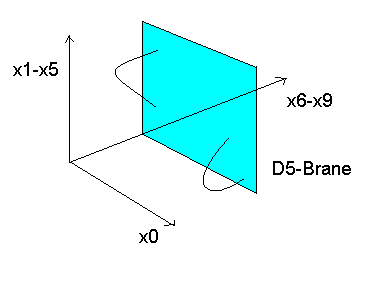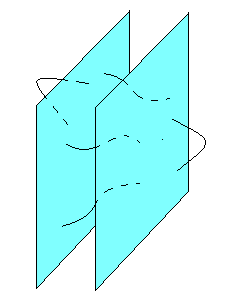| Quantum reality | ||
| Abiotic Evolution | Branes (Super-membranes) |
| Particles | Early Universe | Abiotic Evolution | |
| Abiotic Evolution | Primordial Era | Stars & Galaxies |
Quantum reality |
A brane is a hyperdimensional membrane - just as a string is a hyperdimensional line. It is a dimensional boundary layer of sorts. The term "brane" is a play on "membrane". Branes are defined by the number of dimensions. A two-dimensional surface is a two-brane (D2-brane). Three-dimensional space, such as the known physical universe is a three-brane D3-brane) moving through time. "D" stands for dimension. So a D5-brane is a five dimensional hyper-surface which propagates in time, thus being a six dimensional space-time structure.
"D-branes" can be described simply as boundary conditions in perturbative string theory. A D-brane is the place where superstrings can end. This can be shown by the diagram below:

In this example we have a D5-brane (shown in blue). This constitutes a slice of (hyper)space with the coordinates (x0,x1,x2,x3,x4,x5) where "x" is the particular dimension.
With superstrings propagating in ten dimensional spacetime (x0,x1,….,x9, ), in the case of the D5-brane, strings (shown as the curved lines) can end at a point in the (6 or higher dimensional space (x6-x9 on the diagram). That is, the string endpoints are anywhere in the six dimensional space-time.
diagram from D-Brane Technology - D-Branes as Boundary Conditions by Clifford V. Johnson
The world-volume of a D5-brane is a five dimensional hyper-surface in the theory which propagates in time x0, thus defining a six dimensional space-time.

Here (left) we have a pair of D-branes, with superstrings stretching between them.
When the brane-brane strings are stretched, their vibrations have masses proportional to their length times their tension, and hence they do not generate addtional fields. If however the branes become coincident - that is, if they occupy the same place or position, new massless fields enter the theory.
These new fields coming from brane-brane string modes with coordinates parallel to the spacetime world-volume produce extra vectors in the theory. For N coincident branes ("N" means a certain numner, or any number), the gauge symmetry gets enhanced to U(N). ("U" being the symmetry group. The larger N is the more complex the group). There are also N ![]() scalars coming from the modes with coordinates transverse to the world-volume. These are the positions of the N branes in the transverse space.
scalars coming from the modes with coordinates transverse to the world-volume. These are the positions of the N branes in the transverse space.
diagram from D-Brane Technology - D-Branes as Boundary Conditions by Clifford V. Johnson
Moving the branes away from each other will break the gauge symmetry from U(N) to a subgroup. This is the Higgs mechanism. The motion of branes in space-time may be described by the simple dynamics of the gauge theories which arise on their space-time world volumes.
Standard particles like photons, quarks and leptons, exist only in three-dimensional subspace, a three-brane. But there are also hidden (hyperspace) dimensions, known as "the bulk". While matter and light stick to the lower dimensonal branes, gravity traverses both branes and bulk. The possibility of superstrings having effects at relatively low energies allows the possibility of hidden dimensions could be around a millimeter across. In these hidden dimensions, the 3 dimensions of our universe would be extremely thin (about 10-millionth of a billionth of a millimeter) but these universes woul exist in other dimensions, which are extremely thin relative to our universe.
Such parallel 3-D universes, or three-branes, might contain unusual forms of matter, possibly forming stars, planets, etc. The specific laws of physics would be different, but the laws of gravity would be the same, because gravity can move across the braneworlds
Such hidden worlds might explain the problem of the missing mass in the universe, the so-called "dark matter", needed to balance out the expansion of the universe. It is also neeed to explain the behaviour of galaxies. Galaxies spin as though they they are a single unit, not a loose agregation of stars. They also appear to contain matter far beyond their visible edges; occasionally distant stars brighten as though an intervening massive object has "lensed" their light by gravitational bending.
But critics have pointed out that hidden millimeter-sized dimensions might conflict with observational data about the universe and its past. Many brane scenarios are inconsistent with current estimates of the age of the universe and measurements of the amounts of various chemical elements created in the big bang. It is also hard to reconcile certain brane approaches with a constant strength of gravity in the universe today. But it is too early to say if these objections apply to all versions of the brane approach or just those proposed so far. MAK991120
Stretching your brane - Hidden space dimensions may permit parallel universes, explain cosmic mysteries - by Tom Siegfried / The Dallas Morning News - good basic nontechnical intro
D-branes - short entry - John M. Pierre's superstrings site
Putting String Duality to Work by Clifford V. Johnson - a rather more technical coverage, although it should be no trouble if you have some basic familiarity with tertiary level maths and physics (which I dont have lol ;-).
"This presentation is intended to give a flavour of the physics to be studied and discovered by exploiting the interface between string theory, M-theory and field theory provided by the dynamics of extended objects called 'branes', and their relationships under string duality. It is quite non-technical, with very few equations but many pictorial illustrations to aid the reader."| Particles |
page MAK991120